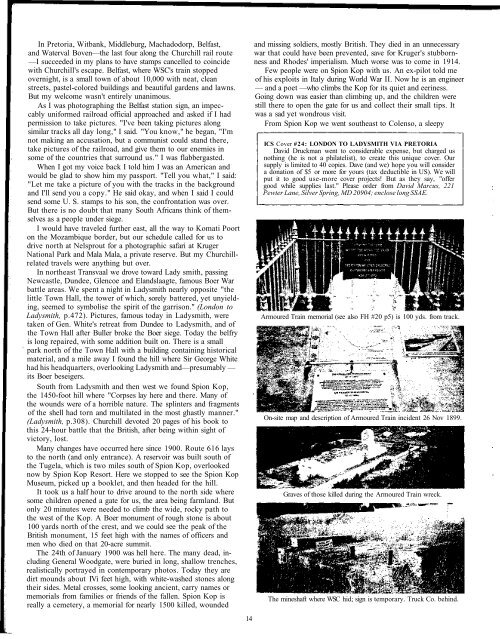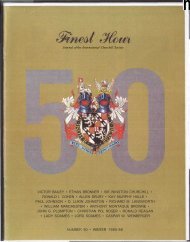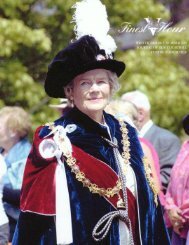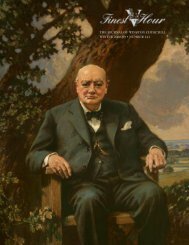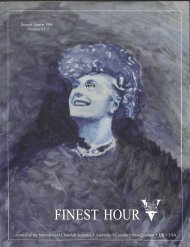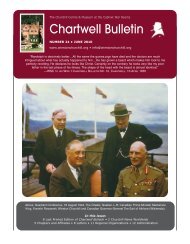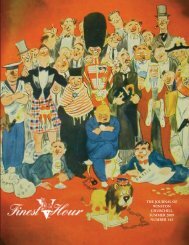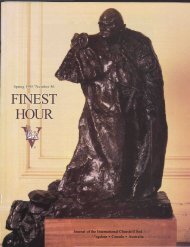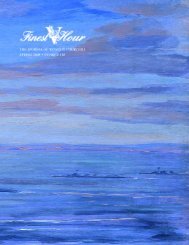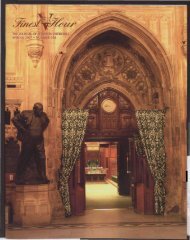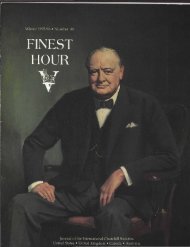Journal of the International Churchill Society - Winston Churchill
Journal of the International Churchill Society - Winston Churchill
Journal of the International Churchill Society - Winston Churchill
You also want an ePaper? Increase the reach of your titles
YUMPU automatically turns print PDFs into web optimized ePapers that Google loves.
In Pretoria, Witbank, Middleburg, Machadodorp, Belfast,<br />
and Waterval Boven—<strong>the</strong> last four along <strong>the</strong> <strong>Churchill</strong> rail route<br />
—I succeeded in my plans to have stamps cancelled to coincide<br />
with <strong>Churchill</strong>'s escape. Belfast, where WSC's train stopped<br />
overnight, is a small town <strong>of</strong> about 10,000 with neat, clean<br />
streets, pastel-colored buildings and beautiful gardens and lawns.<br />
But my welcome wasn't entirely unanimous.<br />
As I was photographing <strong>the</strong> Belfast station sign, an impeccably<br />
uniformed railroad <strong>of</strong>ficial approached and asked if I had<br />
permission to take pictures. "I've been taking pictures along<br />
similar tracks all day long," I said. "You know," he began, "I'm<br />
not making an accusation, but a communist could stand <strong>the</strong>re,<br />
take pictures <strong>of</strong> <strong>the</strong> railroad, and give <strong>the</strong>m to our enemies in<br />
some <strong>of</strong> <strong>the</strong> countries that surround us." I was flabbergasted.<br />
When I got my voice back I told him I was an American and<br />
would be glad to show him my passport. "Tell you what," I said:<br />
"Let me take a picture <strong>of</strong> you with <strong>the</strong> tracks in <strong>the</strong> background<br />
and I'll send you a copy." He said okay, and when I said I could<br />
send some U. S. stamps to his son, <strong>the</strong> confrontation was over.<br />
But <strong>the</strong>re is no doubt that many South Africans think <strong>of</strong> <strong>the</strong>mselves<br />
as a people under siege.<br />
I would have traveled fur<strong>the</strong>r east, all <strong>the</strong> way to Komati Poort<br />
on <strong>the</strong> Mozambique border, but our schedule called for us to<br />
drive north at Nelsprout for a photographic safari at Kruger<br />
National Park and Mala Mala, a private reserve. But my <strong>Churchill</strong>related<br />
travels were anything but over.<br />
In nor<strong>the</strong>ast Transvaal we drove toward Lady smith, passing<br />
Newcastle, Dundee, Glencoe and Elandslaagte, famous Boer War<br />
battle areas. We spent a night in Ladysmith nearly opposite "<strong>the</strong><br />
little Town Hall, <strong>the</strong> tower <strong>of</strong> which, sorely battered, yet unyielding,<br />
seemed to symbolise <strong>the</strong> spirit <strong>of</strong> <strong>the</strong> garrison." (London to<br />
Ladysmith, p.472). Pictures, famous today in Ladysmith, were<br />
taken <strong>of</strong> Gen. White's retreat from Dundee to Ladysmith, and <strong>of</strong><br />
<strong>the</strong> Town Hall after Buller broke <strong>the</strong> Boer siege. Today <strong>the</strong> belfry<br />
is long repaired, with some addition built on. There is a small<br />
park north <strong>of</strong> <strong>the</strong> Town Hall with a building containing historical<br />
material, and a mile away I found <strong>the</strong> hill where Sir George White<br />
had his headquarters, overlooking Ladysmith and—presumably —<br />
its Boer beseigers.<br />
South from Ladysmith and <strong>the</strong>n west we found Spion Kop,<br />
<strong>the</strong> 1450-foot hill where "Corpses lay here and <strong>the</strong>re. Many <strong>of</strong><br />
<strong>the</strong> wounds were <strong>of</strong> a horrible nature. The splinters and fragments<br />
<strong>of</strong> <strong>the</strong> shell had torn and multilated in <strong>the</strong> most ghastly manner."<br />
(Ladysmith, p.308). <strong>Churchill</strong> devoted 20 pages <strong>of</strong> his book to<br />
this 24-hour battle that <strong>the</strong> British, after being within sight <strong>of</strong><br />
victory, lost.<br />
Many changes have occurred here since 1900. Route 616 lays<br />
to <strong>the</strong> north (and only entrance). A reservoir was built south <strong>of</strong><br />
<strong>the</strong> Tugela, which is two miles south <strong>of</strong> Spion Kop, overlooked<br />
now by Spion Kop Resort. Here we stopped to see <strong>the</strong> Spion Kop<br />
Museum, picked up a booklet, and <strong>the</strong>n headed for <strong>the</strong> hill.<br />
It took us a half hour to drive around to <strong>the</strong> north side where<br />
some children opened a gate for us, <strong>the</strong> area being farmland. But<br />
only 20 minutes were needed to climb <strong>the</strong> wide, rocky path to<br />
<strong>the</strong> west <strong>of</strong> <strong>the</strong> Kop. A Boer monument <strong>of</strong> rough stone is about<br />
100 yards north <strong>of</strong> <strong>the</strong> crest, and we could see <strong>the</strong> peak <strong>of</strong> <strong>the</strong><br />
British monument, 15 feet high with <strong>the</strong> names <strong>of</strong> <strong>of</strong>ficers and<br />
men who died on that 20-acre summit.<br />
The 24th <strong>of</strong> January 1900 was hell here. The many dead, including<br />
General Woodgate, were buried in long, shallow trenches,<br />
realistically portrayed in contemporary photos. Today <strong>the</strong>y are<br />
dirt mounds about IVi feet high, with white-washed stones along<br />
<strong>the</strong>ir sides. Metal crosses, some looking ancient, carry names or<br />
memorials from families or friends <strong>of</strong> <strong>the</strong> fallen. Spion Kop is<br />
really a cemetery, a memorial for nearly 1500 killed, wounded<br />
and missing soldiers, mostly British. They died in an unnecessary<br />
war that could have been prevented, save for Kruger's stubbornness<br />
and Rhodes' imperialism. Much worse was to come in 1914.<br />
Few people were on Spion Kop with us. An ex-pilot told me<br />
<strong>of</strong> his exploits in Italy during World War II. Now he is an engineer<br />
— and a poet —who climbs <strong>the</strong> Kop for its quiet and eeriness.<br />
Going down was easier than climbing up, and <strong>the</strong> children were<br />
still <strong>the</strong>re to open <strong>the</strong> gate for us and collect <strong>the</strong>ir small tips. It<br />
was a sad yet wondrous visit.<br />
From Spion Kop we went sou<strong>the</strong>ast to Colenso, a sleepy<br />
ICS Cover #24: LONDON TO LADYSMITH VIA PRETORIA<br />
David Druckman went to considerable expense, but charged us<br />
nothing (he is not a philatelist), to create this unique cover. Our<br />
supply is limited to 40 copies. Dave (and we) hope you will consider<br />
a donation <strong>of</strong> $5 or more for yours (tax deductible in US). We will<br />
put it to good use-more cover projects! But as <strong>the</strong>y say, "<strong>of</strong>fer<br />
good while supplies last." Please order from David Marcus, 221<br />
Pewter Lane, Silver Spring, MD 20904; enclose long SSAE.<br />
Armoured Train memorial (see also FH #20 p5) is 100 yds. from track.<br />
On-site map and description <strong>of</strong> Armoured Train incident 26 Nov 1899.<br />
Graves <strong>of</strong> those killed during <strong>the</strong> Armoured Train wreck.<br />
The mineshaft where WSC hid; sign is temporary. Truck Co. behind.<br />
14


